 The picture below, from 2018, shows what Thanksgiving really ought to look like: And it only shows half the table! For years, we've celebrated Thanksgiving at my sister Phyllis's house in Conway, Massachusetts. But in November 2020, with the COVID-19 pandemic raging, such a celebration would have been very unwise. So for the first time in years, Margie and I celebrated Thanksgiving with only our two daughters and their families. Our younger daughter Sara, her husband Sam, their son Simon, and Sam's mother Plum were all able to quarantine for two weeks prior to the event. Note 1 Thus we felt safe welcoming them into our home. We are with them in a "pod". However, that could not be done with our older daughter Elissa, her husband Ryan, and their daughter Darwin. Ryan teaches at a private school, and goes there to work, necessarily having some exposure to others. And Darwin, in the second grade, goes into school two days a week. They are more apt to be exposed to the virus. And Margie and I, in the second half of our seventies, are at greater risk of complications should we become infected with the virus. Over the summer, the solution has been to meet outdoors, wearing masks and keeping our distance. We have an ample back yard, and if the weather was bad, we'd just re-schedule. But we live in New England. By Thanksgiving, the fourth Thursday in November, the weather starts to turn cold. And winter looms. I thought, is there any way we can keep up our "socially-distanced" get-togethers over the winter? We have a small room off our kitchen and living room, about 3.80 X 3.25 meters (12' 6" X 10' 8"). It is separated from our living room by a 2.29 meter (7.5 feet) double-paned sliding glass door. The two outer walls of the room are almost all glass. I'll call it a "sunroom", although our house is surrounded by so many trees that it doesn't get much sun. Key to the plan: it also has a door to the outside. The idea: have guests enter the sunroom from the outside, without going through our house. We could then visit with them from the opposite side of the sliding glass door. The problem: the sliding glass door blocks sound from the sunroom, being a well-insulated double-paned door normally used as an exterior door. You can't carry on a conversation through that door when it's closed. The solution: Open the door a bit, and stretch a plastic film across the opening to act as a barrier. This allows sound to travel between the two rooms, making conversation possible, while completely blocking airflow that could carry the virus. The picture below shows the two cardboard frames I built, fitted with plastic film 6 mils thick (0.15 mm). The photo shows each of the two frames from a different side. The smaller (top) frame on the left shows how I reinforced the cardboard on one side by gluing on some strips of a cardboard honeycomb packing material I had lying around, to provide stiffness. The larger (bottom) frame on the right shows the side the 6-mil plastic is taped to. A yardstick between the frames gives an idea of the size. Note 2  Why did I use two frames instead of a single long one? On the left side and on the top and bottom, the cardboard fits into the extruded aluminum strips that the glass door slides in, making for a good seal. The bottom cardboard frame drops down into the bottom channel. The top cardboard frame slides up into the top channel. They are then joined in the middle, and taped together. This keeps them firmly in place. Note 3 The picture on the left below shows the frames actually installed in their place in the door, although they had not yet been fully taped into place. I decided to divide the opening in the bottom frame into two parts, to provide greater stiffness. But I verified that there would be plastic film, not cardboard, at Darwin's eye level. We know Darwin's height - it's been regularly marked in pencil on one of our walls as she's grown through the years. The picture on the right below shows one more detail: the sliding glass door only is completely sealed when it is closed. When it is partially opened, there's a path for air to flow between the sliding part of the door and the fixed pane of glass behind it. I filled that opening by using a foam "pool noodle", cut in half to make it fit. 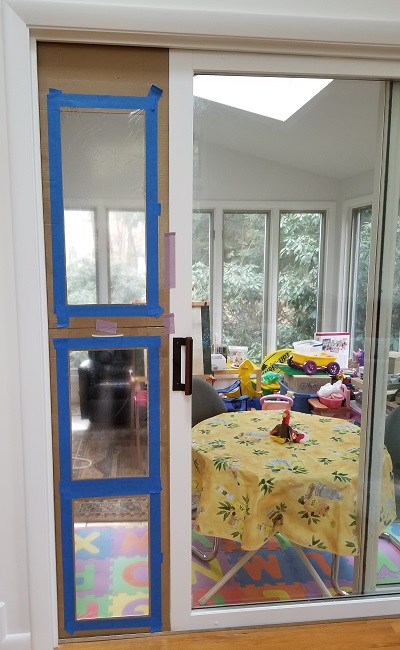  The result was, I think, incredibly successful. The picture below shows our extended Thanksgiving dinner (taken when we had already reached dessert). On our side of the divider, we moved our dining room table into the living room, and placed it up close to the glass. I think we managed to get as close as we could, under the circumstances, to a feeling of having everyone seated at one long table. 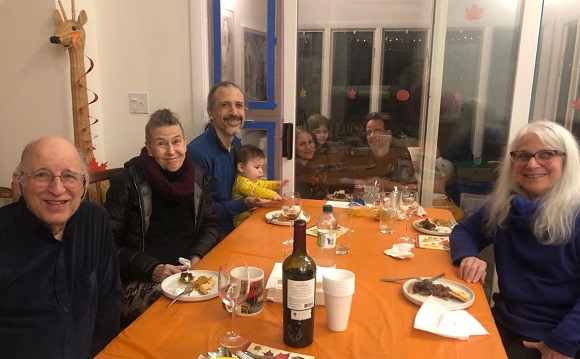 The next photo gives a better view of the participants in the sunroom, which is a step down from the living room. We made sure the sunroom was equipped with amenities such as comfortable chairs, a coat rack, tissues, paper towels, and a trash container. The table was covered with a disposable tablecloth, and disposable plates and utensils were used. The sunroom is heated, but due to the large expanse of glass on two of its walls, it becomes cold if it is sealed off. Running an electric heater kept it cozy, even though this Thanksgiving, the day was rainy. Margie created a treasure hunt completely within the sunroom to start Darwin's evening off with an interesting activity - Darwin quite enjoyed it. Some additional small gifts kept her entertained. Even though she was confined to a small space, she kept herself entertained, as the sunroom has been used as her playroom, full of toys, for her whole life, so it was filled with things for her to do. 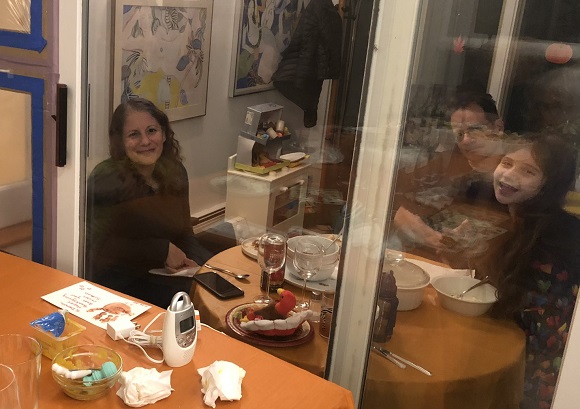 The area of plastic film, even though it was off to only one side, made it possible to carry on a conversation between the two rooms. But there turned out to be the possibility of even closer contact, one that we had not anticipated: contact through the plastic film. The photo below shows Simon and Darwin interacting, almost touching, through the film! 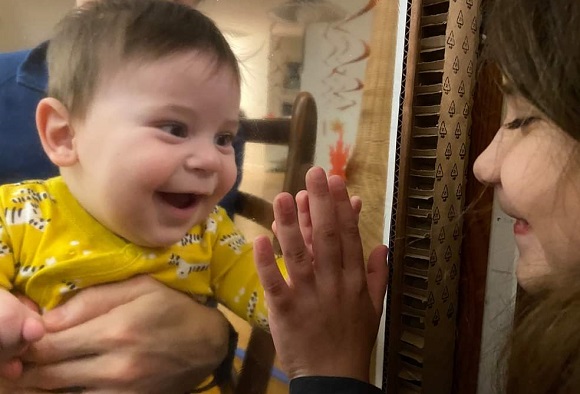 The project worked out very well. We have left it in place, and plan on using it over the winter to allow other people to visit us safely. A couple of more photos below give some additional detail. The first shows the entrance path from our back patio, around our living room, to the outside door of the sunroom. Because rain was predicted on Thanksgiving evening, I put up a sign warning that the flagstone walkway could get a little slippery: 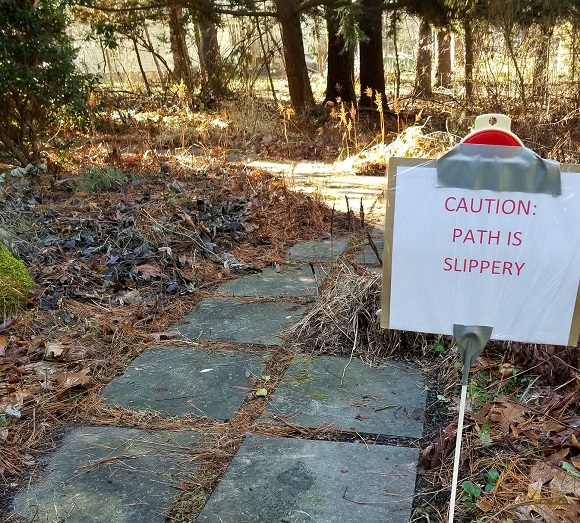 Just a bit outside the sunroom door, I set up an improvised table made out of two large storage boxes, stacked. This was a point to be used to safely transfer food, or anything else we needed to deliver, to our guests in the sunroom. We could go out our back door, and walk around the living room, and leave these items on the table. Our guests could come out of the sunroom to pick them up. Because it rained on Thanksgiving, I also set up a large beach umbrella over the table, to keep everyone relatively dry during these transfers: 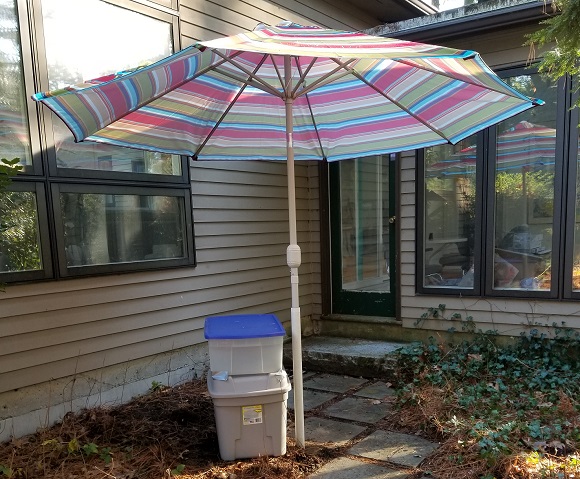 There's a door from the kitchen to the sunroom, but for COVID-19 isolation, we didn't use it. Clean-up afterward was straightforward, starting with just waiting a day before entering the sunroom. Elissa and Ryan had already thrown the disposable items into the trash bag provided, and unplugged the heater. The next day I disposed of the single-use tablecloth. Doorknobs and other surfaces can be easily sanitized. But we also intend to always leave a few days between different guests, as any virus is thought to settle from the air, and become inactive on surfaces over time. We thought this was a successful project for Thanksgiving, and we'll see how it works out for other visitors over the course of this winter. Inspired by what we did, one other person has already noted she intends to do something similar at her house, where she also has a room with an exterior door. Thus I thought it would be worthwhile to document the project in this blog entry. I fervently hope that after this winter, vaccines will end the pandemic.
  Note 1: Quarantining meant no getting together with anyone, including medical appointments, and no going into stores. All our shopping was done using InstaCart. Items coming into the house, including mail, were put aside for a few days. Packaging was removed or sanitized. [return to text] Note 2: This footnote gives details that I thought might be excessive if included above: My original thought was to open the door fully, and fill the entire space with a large piece of plastic film, mounted to a wooden frame. I ultimately decided to open the door only partially, to make the frame carrying the film easier to construct. My initial thought was to make a frame for the plastic film out of wood. But I had a couple of large, heavy pieces of cardboard available, so I used that instead. The cardboard is coated with clear packing tape on one side, to allow masking tape to be used to adhere it to the sliding door and the door frame, yet still be easily removed without damage. My first try at a plastic film was to use a plastic food wrap, Kirkland stretch-tite®, from Costco. It has the great advantage of being extremely clear, and of allowing sound to pass with almost no attenuation. But it has the great disadvantage of being too easily punctured, being only about 0.35 mils in thickness (about 0.0089 mm). I looked at some 3-mil plastic bags I had, and decided that a clear plastic material of about twice that thickness would be suitable. I used various types of tape in this project. Clear packing tape was used to coat the cardboard frames on one side. Two different masking tapes were used, both Scotch® brand tape from 3M. The plastic film is held in place by Scotch-Blue™ Painter's Tape for Multi-Surfaces #2090. It holds quite well, but can be removed and replaced if a plastic film pane gets damaged or dirty. Finally, the entire frame assembly is taped to the door frame and the door with Scotch Delicate Surface Painter's Tape #2080. It provides a good seal with little risk of damaging the finish of the door. One of the problems I might have encountered had I tried to use wood in a project to be accomplished during the pandemic: it would have been very hard for me to buy wood. Remember, I'm not going into stores, and I certainly didn't want to go into, for instance, Home Depot in order to pick out the wood I would need. I could have tried another approach, of course: leave the door fully closed, and build an electronic sound system allowing conversation across the barrier - a microphone on each side connected to a speaker on the opposite side. I thought this would be difficult to do, however, in a manner that would be intelligible, yet prevent runaway feedback. For non-US readers: the "yardstick" in the photo is marked off in the English-system units "inches" (1 inch = 2.54 cm). A "foot" is 12 inches, and a "yard" is 3 feet. So the yardstick is just a bit shorter than a meter; specifically, 1 yard = 0.9144 meters. [return to text] Note 3: An issue I didn't think of until we had it set up is the fact that opening the outside door produces an abrupt change in air pressure in the sunroom. When I first set up the divider, I had not yet taped it in place. When I opened the door from the kitchen to the sunroom (a door which opens into the kitchen), so much air was sucked out of the sunroom that the cardboard frames popped inward. The seal between the sunroom and the living room is good, but it's hardly a hermetic seal, so such pressure changes do produce some exchange of air (and with it, perhaps some droplets carrying virus particles). I just seal it as best I can, and I also put signs on the exterior door instructing that it be opened and closed slowly. [return to text]
 |
